Cheese has long been a beloved dairy product, adored for its rich flavours and versatility. However, concerns about its impact on health have left many wondering: Is cheese actually healthy? In this blog post, we will delve into the nutritional value of cheese and explore the healthiest cheeses available.
SEE ALSO: The Cheese Wanker’s Index of Nutrition Facts by Cheese →
Is cheese actually healthy?
Eating healthy plays a pivotal role in maintaining overall well-being and preventing chronic diseases. A balanced and nutritious diet provides our bodies with essential vitamins, minerals, and macronutrients, fuelling optimal physical and cognitive function.
So, this leads us to the question: is cheese healthy? Well, there is no straight-forward answer to this question. The reason for this is that all cheeses are different. While some may be high in good fats, others may contain too much bad fats or salt.
On the other hand, most cheeses are a good source of protein and calcium.
Which type of cheese is healthiest?
Furthermore, as consumers, we all have different dietary needs. As a result of this, a cheese that’s a good option for one person may not be suitable for another.
For this reason, we will break this post into separate sections looking at specific nutritional assessments.
Cheeses with a high protein content
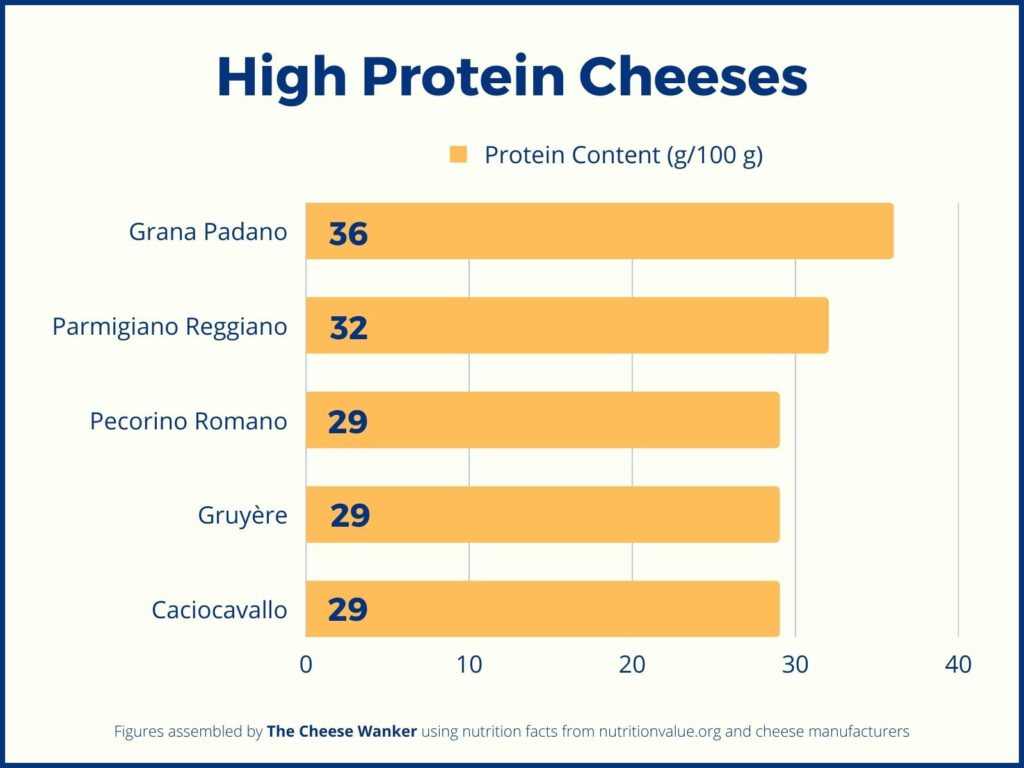
Let’s get the ball rolling with an assessment of the protein content in cheese. Protein is an essential nutrient that plays a vital role in numerous bodily functions. As a result, incorporating high protein cheeses into your diet can provide a significant boost.
More specifically, protein helps build and repair tissues, supports the immune system and contributes to satiety. Actually, the recommended daily protein intake for the average adult is approximately 0.8 grams per kilogram of body weight¹.
You can read more about why cheese contains protein in our dedicated post here.
Now, let’s have a look at five cheeses that are very high in protein.
Grana Padano (36 g of protein²)
Originating from northern Italy, Grana Padano is a renowned cheese that dates back to the 12th century. Made from cow’s milk, this pressed cooked cheese is aged for a minimum of nine months, resulting in a pale-yellow interior with a granular texture.
Grana Padano offers a delicate and nutty flavour, perfect for grating over pasta dishes or enjoying on its own as a table cheese.
READ MORE: Complete nutritional profile for Grana Padano →
Parmigiano Reggiano (32 g of protein²)
Hailing from the Emilia-Romagna region of Italy, Parmigiano Reggiano is an iconic cheese with a history spanning over nine centuries. Known as the “King of Cheeses”, local artisans craft this cheese from raw cow’s milk and age their wheels for a minimum of 12 months.
This hard, granular cheese boasts a rich, complex flavour profile with notes of fruit, nuts and umami. Undoubtedly, Parmigiano Reggiano is a staple in Italian cuisine, and you can enjoy it grated over pasta, risotto and salads.
READ MORE: Complete nutritional profile for Parmigiano Reggiano →
Pecorino (29 g of protein²)
Another Italian cheese that is packed in protein is Pecorino. Pecorino is a distinctive cheese made from 100% sheep’s milk. It comes in various styles and ageing periods, each offering a unique taste experience.
Young Pecorino tends to be mild, with a slightly tangy flavour, while aged versions develop a more robust profile. Pecorino Romano, one of the most famous types of Pecorino, has a crumbly texture and a salty, tangy taste, making it an ideal grating cheese for pasta dishes.
READ MORE: Complete nutritional profile for Pecorino Romano →
Gruyère (29 g of protein²)
Without a doubt, Gruyère is Switzerland’s most famous cheese with a heritage dating back centuries. Swiss cheesemakers use from raw cow’s milk to craft a semi-hard wonder that boasts a smooth, creamy texture.
Moreover, its flavour is rich, nutty and slightly sweet, with delightful hints of fruit and a subtle earthiness. Gruyère is a versatile cheese that can be enjoyed in a variety of ways. It is perfect for melting, making it a staple in fondue, quiches and gratins.
READ MORE: Complete nutritional profile for Gruyère →
Caciocavallo (29 g of protein²)
Our final high protein cheese is Caciocavallo, an Italian cheese with ancient origins. Traditionally produced using raw milk in southern Italy, it is shaped like a teardrop and hung to age. In more modern times, cheesemakers use either raw or pasteurised cow or sheep milk to make Caciocavallo.
The flavour of Caciocavallo varies depending on the type of milk used and the ageing process. Young Caciocavallo has a mild and buttery taste, while aged versions develop a stronger, more complex flavour. It is a versatile cheese suitable for melting, grilling, or enjoying on a cheese board.
READ MORE: Complete nutritional profile for Caciocavallo →
Looking for more high protein options? We’ve got our top 15 list of the highest protein cheeses here.
Low fat cheeses (saturated and unsaturated fats)
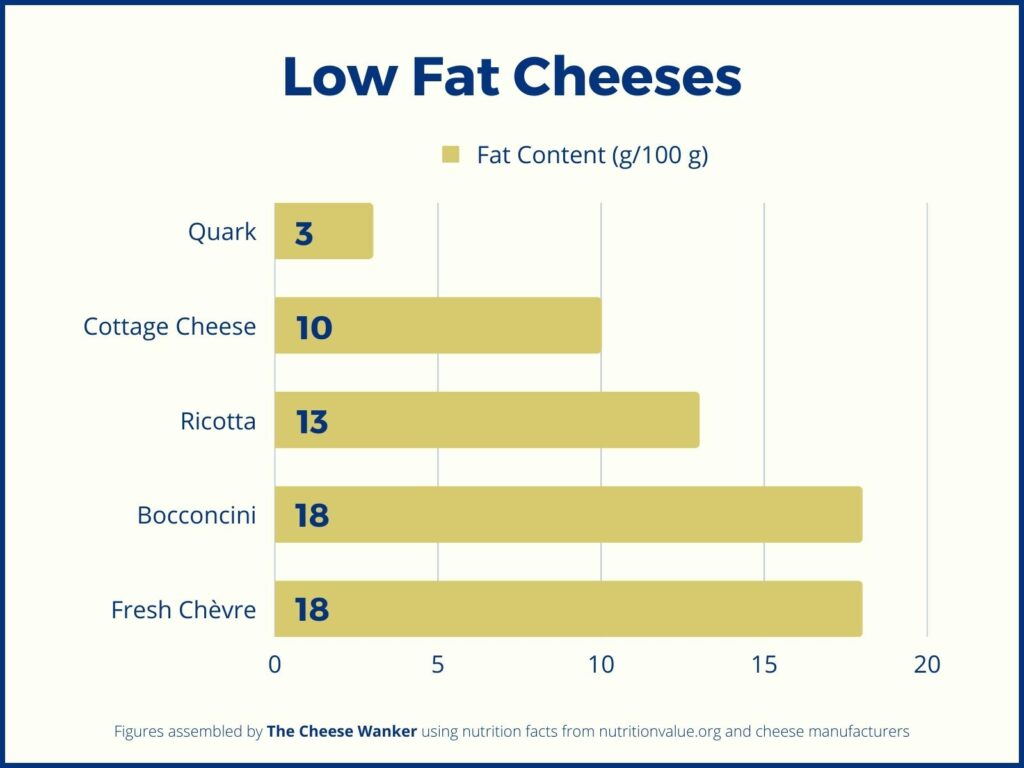
While fat is an important component of a balanced diet, opting for low-fat cheeses can be beneficial for those watching their fat intake.
As you might be aware, there is more than one type of fat in food. And some fats are more detrimental to our health than others⁴. You can read more about the different types of fat in our in-depth post here.
Moreover, some types of cheeses contain less saturated fat³, which is associated with an increased risk of heart disease. Now, let’s dive into our list of five cheeses that are low in fat.
Quark (3 g of total fats²)
Originating from Central Europe, Quark is a fresh cheese that has been enjoyed for centuries. Made by curdling soured milk and then straining the whey, Quark has a smooth and creamy texture similar to yoghurt.
Quark possesses a mildly tangy and slightly sweet flavour, making it a versatile ingredient in both sweet and savoury dishes. Furthermore, Quark is a common ingredient in spreads, dips, desserts and as a topping for fruits. It pairs well with fresh herbs, honey, or jams for added flavour.
READ MORE: Complete nutritional profile for Quark →
Cottage Cheese (10 g of total fats²)
Cottage cheese is a soft and lumpy cheese made from cow’s milk. The curds are gently separated from the whey, resulting in a curd-like texture. Due to its production method, this fresh cheese is low in fat.
It has a mild and slightly tangy taste, with a subtle hint of sweetness. Cottage cheese is a popular nutritious and protein-rich snack. But you can also combine it with fruits, vegetables or savoury ingredients like black pepper and herbs.
READ MORE: Complete nutritional profile for Cottage Cheese →
Ricotta (13 g of total fats²)
Our next low-fat cheese is Italy’s Ricotta. To make this fresh and creamy cheese, Italian cheesemakers would use whey leftover during the production of other cheeses like Mozzarella. Ricotta has a smooth, grainy texture and a delicate, slightly sweet flavour with hints of nuttiness.
This Italian whey cheese is very versatile and shines in both sweet and savoury dishes. It is a popular choice for Italian desserts like cannoli and tiramisu and is also used in pasta fillings, lasagne and pancakes.
READ MORE: Complete nutritional profile for Ricotta →
Bocconcini (18 g of total fats²)
Staying in Italy, Bocconcini is a fresh pasta filata cheese, traditionally made from buffalo milk. These small, round cheese balls have a soft and elastic texture. Bocconcini has a mild and milky flavour with a subtle tang.
It is a common addition to salads, particularly the classic Caprese salad. To make a Caprese salad, you can pair Bocconcini (or other fresh Mozzarella cheeses) with ripe tomatoes, fresh basil and a drizzle of olive oil. You can also enjoy Bocconcini as a snack or add it to pasta dishes and pizzas for a creamy and indulgent touch.
READ MORE: Complete nutritional profile for Bocconcini →
Fresh Chèvre (18 g of total fats²)
Our final low-fat cheese is Fresh Chèvre. This type of goat cheese finds its origins in France and has a creamy and spreadable texture. Fresh Chèvre offers a distinct tangy and slightly acidic flavour profile with hints of citrus and herbs.
This versatile cheese is perfect for spreading on bread or crackers, and it adds a delightful creaminess to salads and sandwiches. It pairs well with fruits like figs or pears, honey and nuts, enhancing the overall taste and texture of dishes.
READ MORE: Complete nutritional profile for Fresh Chèvre →
Looking for more low-fat options? We’ve listed the 15 best cheeses that are low in fat in this post here.
Cheeses that contain a high amount of calcium
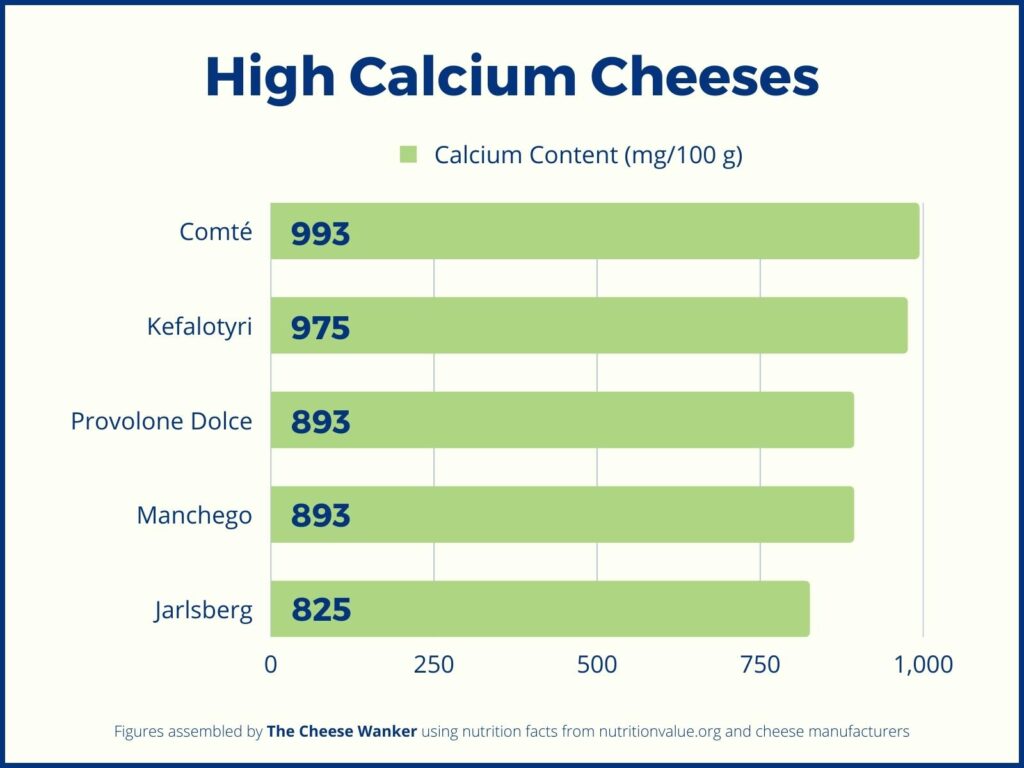
Calcium is crucial for maintaining strong bones and teeth, regulating blood pressure and supporting muscle function. And consuming high calcium cheeses is an excellent way to meet your daily calcium requirements.
Here is our list of five cheeses that have a high calcium content.
Comté (993 mg of calcium²)
Comté finds its origins in the Franche-Comté region in eastern France. Made from unpasteurised cow’s milk, it undergoes a long ageing process, resulting in a firm and dense texture.
This classic mountain cheese boasts an incredibly complex flavour profile that can range from nutty and slightly sweet to fruity and earthy, depending on its age.
Moreover, Comté is a very versatile cheese suitable for a cheeseboard, melting in gratins, or as a delightful addition to sandwiches and salads.
READ MORE: Complete nutritional profile for Comté →
Kefalotyri (975 mg of calcium²)
Our next high calcium cheese comes from Greece. Kefalotyri is a traditional Greek cheese with origins dating back centuries. Made from sheep’s or goat’s milk, this hard and salty cheese often ages for several months before it is ready for consumption.
As a result, Kefalotyri develops a crumbly texture and a robust flavour with tangy and spicy undertones. Because of its texture and flavour, this Greek cheese is a popular ingredient the local cuisine. Some examples of dishes that celebrate Kefalotyri include Pastitsio or Saganaki.
READ MORE: Complete nutritional profile for Kefalotyri →
Provolone Dolce (893 mg of calcium²)
We’re in Italy again for the third highest calcium cheese on our list. Provolone Dolce, originating from southern Italy, is a semi-soft, pasta filata cheese. It is made from cow’s milk and has a mild, buttery flavour with a hint of tanginess.
Provolone Dolce has a smooth and supple texture that becomes more elastic when melted. Hence, you will want to melt this classic cheese in sandwiches, pizzas and pasta dishes.
Furthermore, you can enjoy this sweet pasta filata on its own as a table cheese, or pair it with cured meats, olives and crusty bread.
READ MORE: Complete nutritional profile for Provolone Dolce →
Manchego (893 mg of calcium²)
There is no question that Manchego is Spain’s most iconin cheese. Manchego has a firm and crumbly texture with a pale ivory colour. And its flavour is rich, nutty and slightly tangy, with a pleasant sweetness.
The locals often serve Manchego on a cheeseboard or grated over salads and roasted vegetables. Also, it pairs excellently with Spanish wines, quince paste and Marcona almonds, enhancing its unique characteristics.
READ MORE: Complete nutritional profile for Manchego →
Jarlsberg (825 mg of calcium²)
The final high calcium cheese on our list is Jarlsberg. Originating from Norway, Jarlsberg is a popular cheese known for its sweet and nutty taste. It is made from cow’s milk and has a semi-soft texture with large, irregular holes.
This cheese is versatile and can be enjoyed on sandwiches, melted in dishes like quiches and fondues, or simply savoured on its own.
READ MORE: Complete nutritional profile for Jarlsberg →
Low sodium (salt) cheeses
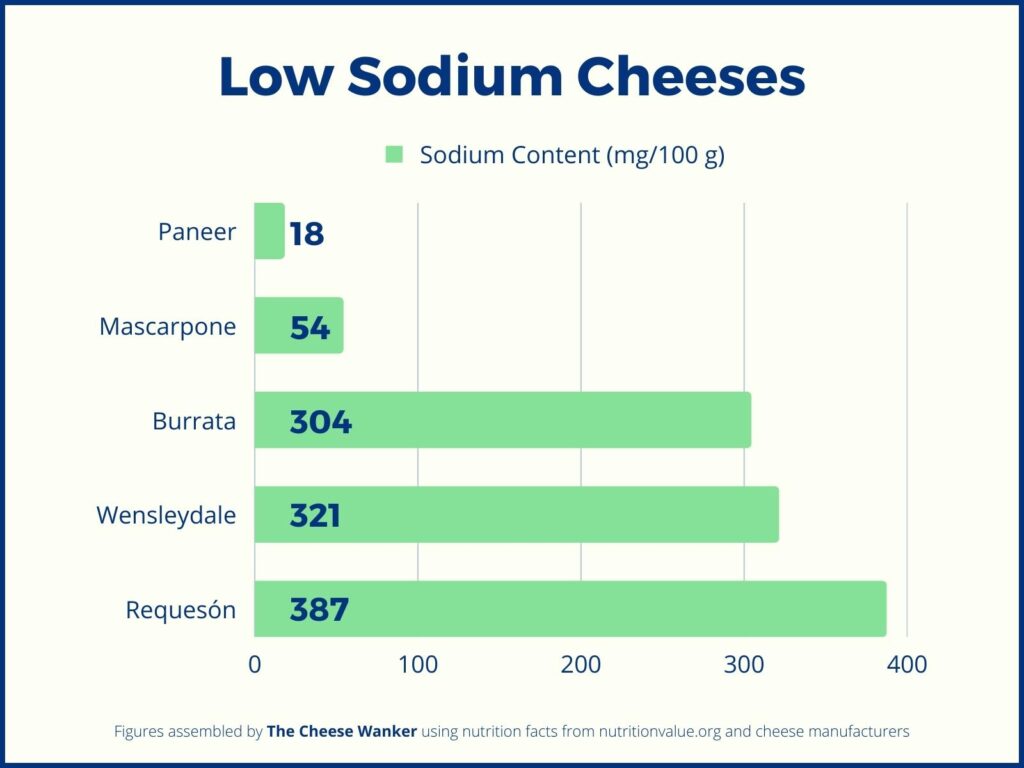
Sodium is an essential mineral involved in various bodily functions, but excessive sodium intake can lead to health issues such as high blood pressure.
Unfortunately, you can’t make cheese without using salt (and sodium). Indeed, salt plays an important role in both the production and ageing of almost every type of cheese.
However, opting for low sodium cheeses can help reduce your overall sodium intake. Reading labels and selecting cheeses with reduced sodium content is advisable for people aiming to limit their sodium intake. Read on for five of the best low sodium cheeses.
Paneer (18 mg of sodium²)
Paneer, originating from the Indian subcontinent, is a fresh cheese commonly used in Indian cuisine. It is made by curdling heated milk with lemon juice or vinegar, resulting in a soft and crumbly texture.
Overall, Paneer has a mild and slightly tangy taste, allowing it to absorb the flavours of the dishes it is used in. It is a versatile cheese used in various Indian recipes such as curries, tikka masala and paneer tikka. Besides, Paneer is a popular choice for vegetarians since it does not contain animal rennet.
READ MORE: Complete nutritional profile for Paneer →
Mascarpone (54 mg of sodium²)
Originally from Italy, Mascarpone is a creamy and indulgent cheese made from cow’s milk. It has a rich, buttery texture and a mildly sweet flavour. Today, Mascarpone is famously used in desserts like Tiramisu, where its velvety consistency adds a lusciousness to the dish.
In addition to Tiramisu, you can add Mascarpone to savoury dishes like pasta sauces or spread it on bread as a delightful topping.
READ MORE: Complete nutritional profile for Mascarpone →
Burrata (304 mg of sodium²)
In the age of social media, one cheese has shone the brightest. Burrata, originating from the Apulia region in southern Italy, is a fresh pasta cheese. It is made from Mozzarella and cream, resulting in a thin, delicate outer shell encapsulating a soft and creamy centre.
Burrata has a mild, milky flavour with hints of sweetness. It is commonly enjoyed in salads, paired with ripe tomatoes, fresh basil and a drizzle of olive oil.
READ MORE: Complete nutritional profile for Burrata →
Wensleydale (321 mg of sodium²)
Wensleydale is a cheese with English origins, specifically from the Wensleydale region in Yorkshire. It is a crumbly and creamy cheese made from cow’s milk. This pressed cheese has a mild and slightly sweet flavour with a pleasant tanginess.
It is often flavoured with different fruits like cranberries or apricots, enhancing its taste profile. Due to the sugar content in most of the flavourings, the healthiest versions of Wensleydale are the unflavoured ones.
READ MORE: Complete nutritional profile for Wensleydale & Cranberries →
Requesón (387 mg of sodium²)
Our final low salt cheese is Requesón. Commonly found in Central and South American cuisines, Requesón is a soft and fresh cheese made from whey. It has a creamy and slightly grainy texture. And a mild and slightly tangy flavour with subtle earthy notes.
It is often used in traditional dishes like empanadas, tamales or spread on tortillas. This whey cheese is very versatile and can be enjoyed in both savoury and sweet recipes.
READ MORE: Complete nutritional profile for Requesón →
Cheeses with low cholesterol content
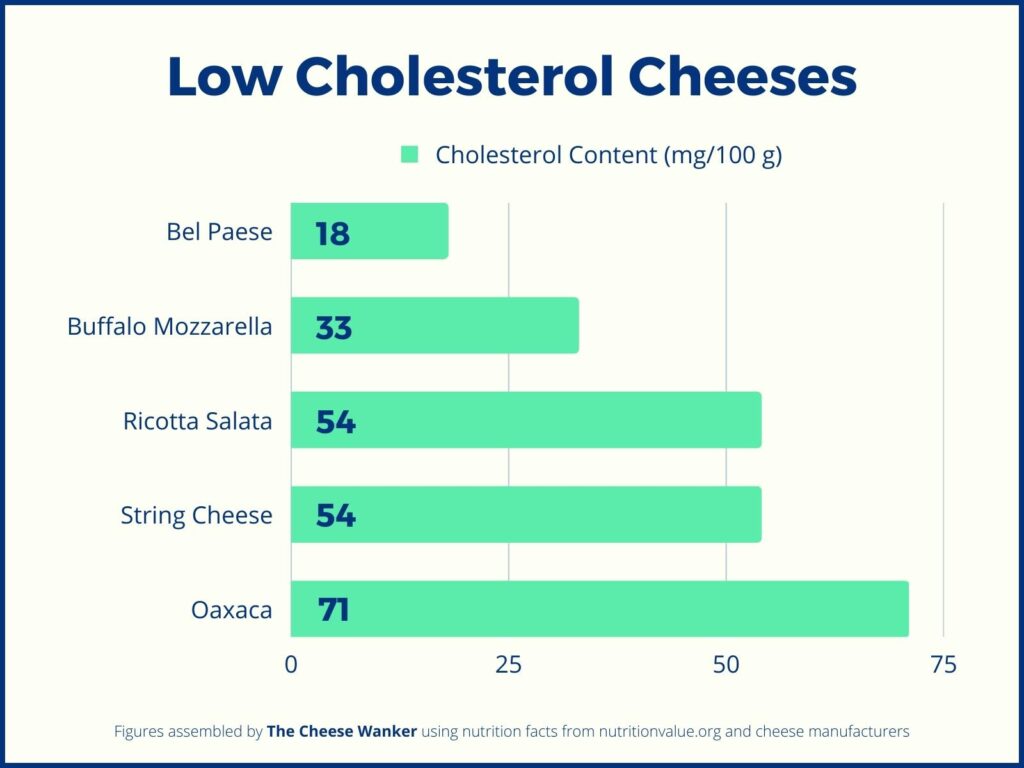
The role of dietary cholesterol in relation to human health has been a topic of scientific debate in recent years. Previously, it was believed that consuming foods high in cholesterol, such as eggs and certain dairy products, would raise blood cholesterol levels and increase the risk of cardiovascular disease.
However, current research suggests that the impact of dietary cholesterol on blood cholesterol levels may not be as significant as once thought⁵. You can read more about this ongoing debate in our post dedicated to cholesterol in cheese here.
Having said that, if you want to limit your cholesterol intake, we’ve got five great low-cholesterol cheeses for you!
Bel Paese (18 mg of cholesterol²)
Bel Paese, originating from Italy, is a semi-soft cheese with a mild and buttery flavour. It was created in the early 20th century as a milder alternative to stronger-smelling cheeses.
This popular pressed cheese has a smooth and creamy texture with a delicate aroma. Due to its mild flavour, it is a popular addition to sandwiches, salads and pasta dishes.
Moreover, this cheese pairs well with fruits, crusty bread, and light-bodied wines, adding a touch of elegance to any meal.
READ MORE: Complete nutritional profile for Bel Paese →
Buffalo Mozzarella (33 mg of cholesterol²)
Also known as Mozzarella di Bufala, Buffalo Mozzarella is a traditional Italian cheese made from the milk of water buffaloes. It has a soft and elastic texture with a delicate and milky flavour.
While you can serve this versatile cheese in many different ways, the most popular dish is most certainly a Caprese salad. Scroll back up to our Bocconcini section for the recipe.
READ MORE: Complete nutritional profile for Buffalo Mozzarella →
Ricotta Salata (54 mg of cholesterol²)
Our next low cholesterol cheese also hails from Italy. Ricotta Salata is a variation of Ricotta cheese that undergoes a process of salting and ageing. Consequently, it develops a firm and crumbly texture and a savoury flavour.
Presently, Ricotta Salata is commonly used as a grating cheese in Italian cuisine, adding a savoury touch to pasta dishes, salads and roasted vegetables.
READ MORE: Complete nutritional profile for Ricotta Salata →
String Cheese (54 mg of cholesterol²)
String Cheese, popularised in the United States, is a type of cheese that is typically made from Mozzarella. Due to its distinctive stringy texture, String Cheese is the ultimate midnight snack. And its a relatively healthy one too!
This version of Mozzarella has a mild and slightly salty flavour, making it appealing to both children and adults.
READ MORE: Complete nutritional profile for String Cheese →
Oaxaca (71 mg of cholesterol²)
The final cheese on our healthiest list hails from Mexico. Oaxaca is a semi-soft pasta filata cheese named after the region where it is traditionally made. It has a stringy and elastic texture, similar to String Cheese or Mozzarella.
On the palate, Oaxaca offers a buttery and slightly tangy taste with a hint of saltiness. It is a common ingredient in Mexican cuisine, in dishes like Quesadillas, Enchiladas and Chiles Rellenos.
READ MORE: Complete nutritional profile for Oaxaca →
Summary: specific cheeses for specific dietary needs
In conclusion, the healthiest types of cheese depend on individual dietary needs and preferences. High protein cheeses provide a protein boost to your diet, while low-fat cheeses help reduce overall fat intake.
Moreover, high calcium cheeses contribute to strong bones and teeth, and low sodium cheeses aid in limiting sodium intake. And finally, low cholesterol cheeses can be a suitable choice for those monitoring their cholesterol levels.
Remember to consult with a healthcare professional or registered dietitian to determine which cheeses align with your specific dietary requirements. With the right choices, cheese can be enjoyed as a delicious and nutritious addition to a well-balanced diet.
Did your favourite cheese not appear on this list? Drop us a comment below and we’ll give you a summary of its nutrition facts.
References
¹ Protein RDI for adult women is 0.75g/kg of body weight and for adult men is 0.84g per kg of body weight: Dietitians Australia
² Cheese nutritional values assembled by The Cheese Wanker using nutrition facts from nutritionvalue.org and/or cheese manufacturers. We realise that there can be variations between different brands and producers. Hence, the numbers we have used are averages.
³ Type of fat in cheese: Harvard T.H. Chan’s The Nutrition Source.
⁴ Fat RDI data and different types of fat: Cleveland Clinic’s Healthy Fat Intake resource.
⁵ Dietary Cholesterol and Cardiovascular Risk: A Science Advisory: American Heart Association
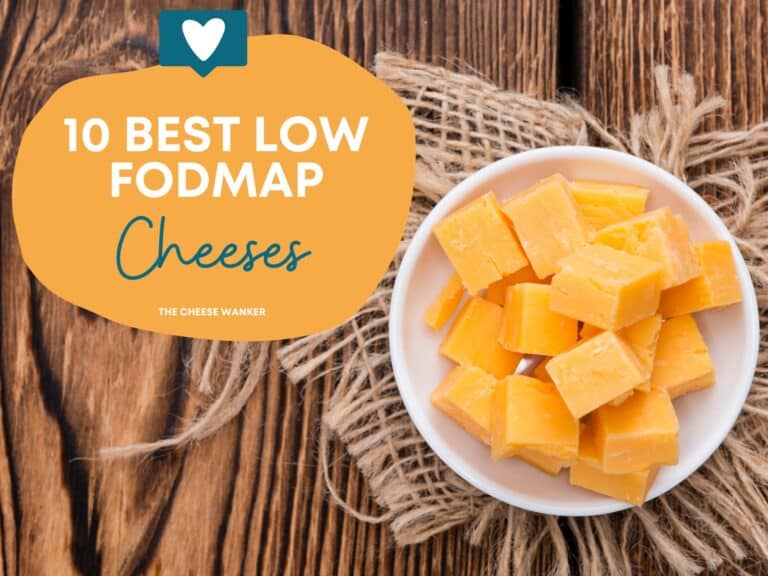
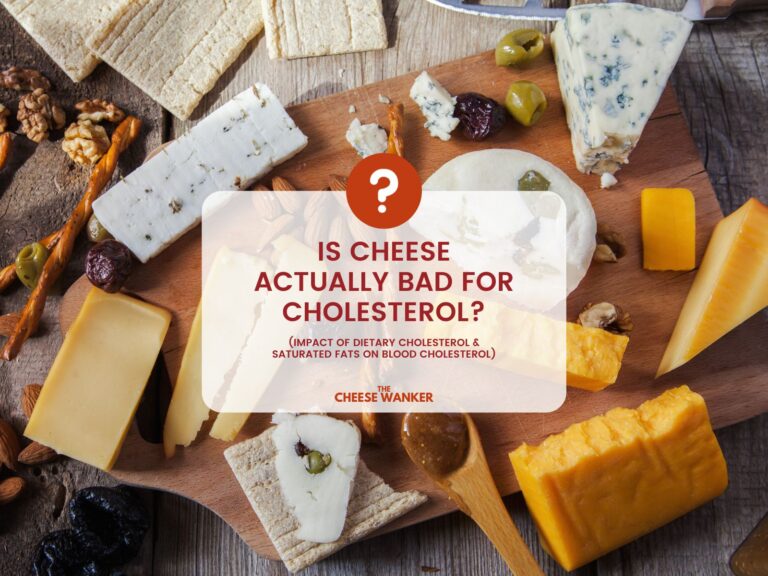
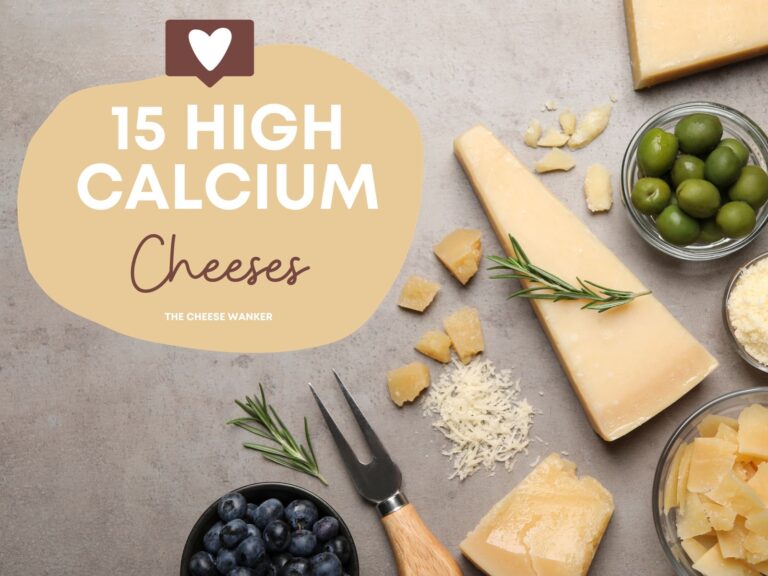

I always try to be healthy and as I have high cholesterol (inherited, not overweight!) I am very mindful about what I eat. I love Cheddar (I’m a Brit, of course I do!) the stronger the better but I try to limit the amount I consume. When I’m in France, the cheese temptation is huge but I couldn’t cut it out altogether, so I just have less. Where do you stand on cottage cheese?! 😂
I’ve got high cholesterol too! Agree with you about Cheddar. And I’m also pretty liberal with most semi-hard cheeses. However, I do approach soft and creamy cheeses with a little bit more caution. Cottage cheese eh? I’d rather have Ricotta or Mascarpone!